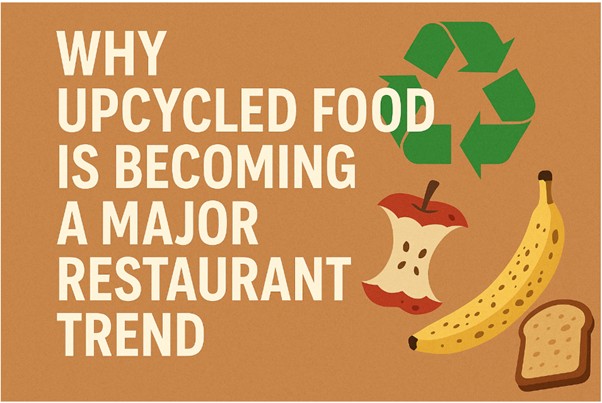
Why Upcycled Food Is Becoming a Major Restaurant Trend
The food industry is facing a pivotal shift toward sustainability, and one of the most intriguing developments in this space is the rise of upcycled food. As awareness grows around food waste, climate change, and resource scarcity, restaurants are seeking innovative ways to do more with less. At the forefront of this movement is Chef Shajahan M. Abdul, founder of Restro Consultants Pvt. Ltd. (RCPL), who champions upcycling as both an eco-friendly solution and a culinary innovation.
But what exactly is upcycled food, and why is it suddenly one of the hottest trends in modern kitchens?
What Is Upcycled Food?
Upcycled food refers to ingredients that typically go to waste—like vegetable peels, fruit pulp, coffee grounds, or imperfect produce—but are repurposed into delicious, high-quality dishes or products. It’s not just about recycling scraps; it’s about transforming them into something beautiful, flavorful, and sustainable.
Chef Abdul says, “Upcycled food isn’t just about reducing waste—it’s about reimagining the kitchen as a space of creativity and responsibility. We’re taking what others discard and turning it into a star on the plate.”
Why Restaurants Are Embracing
the Upcycling Trend
There are several reasons why
upcycled food is capturing the attention of chefs, diners, and restaurant
consultants alike:
1. Reducing Food Waste
Globally, nearly one-third of
all food is wasted. Upcycling directly addresses this issue by repurposing
ingredients that would otherwise be thrown away. For restaurants, this means
lower food costs and a smaller environmental footprint.
Restro Consultants Pvt Ltd
(RCPL) has helped numerous restaurants in India implement waste-reduction
strategies utilising upcycled ingredients, resulting in improved margins and
enhanced sustainability reputations.
2. Appealing to Conscious
Consumers
Today’s diners are more
environmentally aware than ever. They want to support brands that align with
their values. By featuring upcycled dishes, restaurants demonstrate a deep
commitment to sustainability—a quality that resonates with environmentally
conscious guests.
Chef Shajahan M Abdul notes,
“The eco-conscious customer doesn’t just want a great meal—they want to feel
good about how that meal was made.”
3. Fuelling Culinary Creativity
Upcycling challenges chefs to
think outside the box. What was once compost can become a base for broths,
sauces, garnishes, or even desserts. Carrot tops become pesto. Citrus peels
become syrups—coffee grounds flavor brownies.
Chef Abdul explains, “Some of
the best dishes I’ve developed came from what others call waste. Upcycling
forces innovation—and that’s exciting for chefs and customers alike.”
How Restaurants Can
Successfully Introduce Upcycled Food
Implementing upcycling in a
restaurant requires planning, creativity, and the right systems. Here’s how
restaurant consultants recommend getting started:
1. Conduct a Waste Audit
Start by identifying what goes
to waste in your kitchen. Is it bread ends? Vegetable trim? Stale pastries?
Understanding your waste profile helps pinpoint opportunities for upcycling.
Restro Consultants Pvt Ltd
(RCPL) provides clients with detailed waste audit frameworks, enabling them to
track, categorise, and effectively act on food waste data.
2. Train Your Kitchen Staff
Upcycling requires a new way of
thinking. Your team must be trained to consider waste an asset, not a
liability. This includes separating usable scraps and developing prep routines
that support reuse.
Chef Shajahan M Abdul emphasises,
“Your kitchen culture must embrace sustainability. Every chef on the line
should be trained to think, ‘What else can I do with this?’”
3. Create a Signature Upcycled
Dish
Introduce one upcycled dish on
your menu—something you can promote and take pride in. This will give customers
a tangible taste of your mission and give your marketing team a compelling story
worth sharing.
RCPL often works with chefs to
develop upcycled, eco-conscious, and commercially viable dishes.
4. Highlight It in Your
Branding
Be transparent about your
upcycling efforts. Diners love behind-the-scenes stories, so show them how
yesterday’s cauliflower stem became today’s soup base.
Chef Abdul recommends using
menu tags like “Upcycled,” “Waste-Free,” or “Reimagined” and sharing the story
behind the dish on social media.
Common Misconceptions About
Upcycled Food
Some restaurants hesitate to
adopt upcycling because of outdated assumptions. Let’s debunk a few:
Restaurant consultants from
Restro Consultants Pvt Ltd (RCPL) stress the importance of transparency,
training, and taste.
The Future of Upcycled Food
Looking ahead, upcycled food is
expected to become more mainstream. As costs rise and sustainability becomes a
differentiator, more restaurants will turn to upcycling to cut expenses, reduce
environmental impact, and create buzz-worthy dishes.
Tech innovations will also
support the trend—AI-based waste tracking, intelligent storage systems, and
upcycled ingredient suppliers are already integrated into restaurant
ecosystems.
Chef Shajahan M Abdul predicts,
“Upcycling won’t be a niche trend in five years. It’ll be a best practice.
Restaurants that lead now will be the ones that thrive.”
Final Thoughts from Chef
Shajahan M Abdul
Upcycled food represents more
than sustainability—it’s a mindset shift that combines responsibility with
creativity. It’s about reducing waste and elevating food to its fullest
potential.
As Chef Abdul wisely says, “A
great chef sees ingredients not for what they are—but for what they can
become.”
With expert support from
restaurant consultants at Restro Consultants Pvt Ltd (RCPL), restaurants can
adopt upcycled, profitable, and planet-friendly practices. Whether you run a
cloud kitchen or a fine-dining concept, now is the time to rethink how food
waste can become your next bestseller.
Chef Abdul © Copyright 2024. All rights reserved.